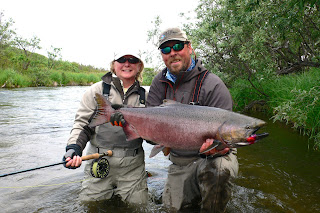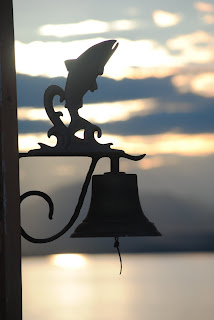There were your New York-ahs, of course.
There was Alexander Hvatsky, a Russian-born tour guide with the busy shop.
Then there was also the Castelli brothers, Federico and Vittorio, who hail from the village of Biella in northwest Italy.
There was Alexander Hvatsky, a Russian-born tour guide with the busy shop.
Then there was also the Castelli brothers, Federico and Vittorio, who hail from the village of Biella in northwest Italy.
And what made them all leave their respective homes, to figuratively hang “gone fishing” signs on their front doors?
Why, to journey to northwest Connecticut and indulge in the fabulous fly fishing of the Housatonic River, or “Hoosie,” as it’s known in these parts.
“Fall is a great time to fish here,” said Torrie Collins, 47, manager of the outfitters, in between helping fishing enthusiast select items in the rustic, supply-stacked store nestled next to the Hoosie.
“You get a real mix of people here. A lot of English people, for some reason,” Collins noted. “It’s well-known, famous fishing area.”
Fisherman from near and far agreed, as the peak fall season for fishing, particularly fly fishing, is winding down on the windy, twisty river, which was finally flowing at regular levels a week after the rains of Hurricane Sandy fell.
“It reminds me of fishing in Montana,” Adam Franceschini, 32, the outfitter’s head guide, said a few miles upstream as he stood in gray “waders,” or overalls, and prepared to launch the Castelli brothers in his blue 12-foot hard rubber raft for an all-day fly fishing excursion.
Why, to journey to northwest Connecticut and indulge in the fabulous fly fishing of the Housatonic River, or “Hoosie,” as it’s known in these parts.
“Fall is a great time to fish here,” said Torrie Collins, 47, manager of the outfitters, in between helping fishing enthusiast select items in the rustic, supply-stacked store nestled next to the Hoosie.
“You get a real mix of people here. A lot of English people, for some reason,” Collins noted. “It’s well-known, famous fishing area.”
Fisherman from near and far agreed, as the peak fall season for fishing, particularly fly fishing, is winding down on the windy, twisty river, which was finally flowing at regular levels a week after the rains of Hurricane Sandy fell.
“It reminds me of fishing in Montana,” Adam Franceschini, 32, the outfitter’s head guide, said a few miles upstream as he stood in gray “waders,” or overalls, and prepared to launch the Castelli brothers in his blue 12-foot hard rubber raft for an all-day fly fishing excursion.
Franceschini makes his living as a full-time fishing guide, taking out fishing parties about 250 days a year. He spends his summers in Alaska, spring and fall here on the Housatonic, and winters catching Red fish in the marshes of the low country near Charleston, S.C. He also spends time on the Salmon River of Pulaski, N.Y.
The Housatonic, he said, “fishes more like a free stone river” in Alaska.
Saturday, as he took the Castelli brothers down the whole 14-miles stretch of the Housatonic between Sharon and South Kent that offers fly fishing, there were plenty of Trout to be had.
That’s because the Connecticut Department of Energy and Environmental Protection (DEEP) agency regularly stocks the Hoosie with 9,000 Rainbow Trout and Brown Trout each April and September, according to Hvatsky, the Russian-born tour guide with the outfitters.
In addition, the Housatonic River Outfitters raises money each year to stock the river with an additional 800 “large size” Rainbow Trout bought from private hatcheries in Pennsylvania, said Collins, the outfitter’s manager. The large size trout range from 14 to 18 inches long, he said.
Hvatsky said during the spring and fall the outfitters arrange tours for Europeans “pretty much every weekend” – usually those who are traveling to New York City for business and have free time on the weekend.
In Europe, Hvatsky said, fishermen usually need a special permit for every river they fish. The rivers there are typically owned and maintained by private landowners who don’t want intruders on their property, he said.
But in Connecticut, and the rest of the United States, rivers are run by federal, state and local governments, and are free to the public, he added.
In Italy, the Castellis fly fish in “much smaller streams,” which are located in “real mountains” – the Alps, said Vittorio Castelli, a researcher who lives in Westchester County, N.Y. and was hosting his brother Federico, an accountant who was on a business trip to the city from their hometown of Biella.
“It’s wonderful, what a beautiful area,” Federico marveled. “From one of the biggest cities in the world you drive [not much more than] an hour and here you are, in the middle of nowhere, fly fishing in this nice river.”
The Housatonic, he said, “fishes more like a free stone river” in Alaska.
Saturday, as he took the Castelli brothers down the whole 14-miles stretch of the Housatonic between Sharon and South Kent that offers fly fishing, there were plenty of Trout to be had.
That’s because the Connecticut Department of Energy and Environmental Protection (DEEP) agency regularly stocks the Hoosie with 9,000 Rainbow Trout and Brown Trout each April and September, according to Hvatsky, the Russian-born tour guide with the outfitters.
In addition, the Housatonic River Outfitters raises money each year to stock the river with an additional 800 “large size” Rainbow Trout bought from private hatcheries in Pennsylvania, said Collins, the outfitter’s manager. The large size trout range from 14 to 18 inches long, he said.
Hvatsky said during the spring and fall the outfitters arrange tours for Europeans “pretty much every weekend” – usually those who are traveling to New York City for business and have free time on the weekend.
In Europe, Hvatsky said, fishermen usually need a special permit for every river they fish. The rivers there are typically owned and maintained by private landowners who don’t want intruders on their property, he said.
But in Connecticut, and the rest of the United States, rivers are run by federal, state and local governments, and are free to the public, he added.
In Italy, the Castellis fly fish in “much smaller streams,” which are located in “real mountains” – the Alps, said Vittorio Castelli, a researcher who lives in Westchester County, N.Y. and was hosting his brother Federico, an accountant who was on a business trip to the city from their hometown of Biella.
“It’s wonderful, what a beautiful area,” Federico marveled. “From one of the biggest cities in the world you drive [not much more than] an hour and here you are, in the middle of nowhere, fly fishing in this nice river.”
Franceschini, their guide, said the brothers are experienced fly fisherman, “better than average.”
Vittorio Castelli, in fact, has fished the Hoosie three others times prior to Saturday’s trip, which saw them catch – and release – six trout, including a few that were 18-inch long, and one 22-inch monster.
“The scenery is fantastic, the river is large, and the fishing’s good,” Vittorio said of the Hoosie.
Collins agreed.
“November can see some great fishing, as long as you don’t mind the cold.”
The outfitters had arranged six guided fly fishing tours this weekend, according to Franceschini, the head guide. He’s been busy since his return from Alaska on Sept. 26.
“The first two weeks I was booked solid everyday,” he said. “It starts to taper off the next couple weeks and by the second week of November we’ll be done.”
Not everyone wants to be done.
Further downstream from where Franceschini started his all-day $350 tour with the Castelli brothers, Jeff Toland of Milbrook, N.Y. was wading in the water alone, casting his fly near the covered bridge in West Cornwall.
“This is my therapy,” said the 54-year-old general contractor, who was raised on Long Island. “I’ve got salt water in my veins, but I really love fresh water fishing.”
Vittorio Castelli, in fact, has fished the Hoosie three others times prior to Saturday’s trip, which saw them catch – and release – six trout, including a few that were 18-inch long, and one 22-inch monster.
“The scenery is fantastic, the river is large, and the fishing’s good,” Vittorio said of the Hoosie.
Collins agreed.
“November can see some great fishing, as long as you don’t mind the cold.”
The outfitters had arranged six guided fly fishing tours this weekend, according to Franceschini, the head guide. He’s been busy since his return from Alaska on Sept. 26.
“The first two weeks I was booked solid everyday,” he said. “It starts to taper off the next couple weeks and by the second week of November we’ll be done.”
Not everyone wants to be done.
Further downstream from where Franceschini started his all-day $350 tour with the Castelli brothers, Jeff Toland of Milbrook, N.Y. was wading in the water alone, casting his fly near the covered bridge in West Cornwall.
“This is my therapy,” said the 54-year-old general contractor, who was raised on Long Island. “I’ve got salt water in my veins, but I really love fresh water fishing.”
gregseigle@aol.com
For The Register Citizen























